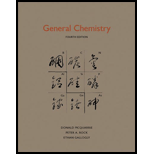
Interpretation:
The value of
Concept Introduction:
Enthalpy of reaction can be used to find heat capacity
Here,
The value heat capacity of unit mole substance is known as molar heat capacity and it is represented by
Here,
Also, The value heat capacity per gram is known as specific heat capacity and it is represented by
Here,
In calorimeter, when heat is released it can only be absorbed by contents of calorimeter. This results in an increase in temperature. Since all heat released is absorbed by calorimeter thus change in enthalpy of reaction is written as follows:
In bomb calorimeter, the expression of energy change in the reaction is written as follows:
Answer to Problem 14.65P
The value of
Explanation of Solution
The chemical equation for combustion of oxalic acid is as follows:
The expression to calculate number of moles of oxalic acid is as follows:
Substitute
The expression to calculate energy of combustion reaction is as follows:
Substitute
Since value of
The value of
The expression of
Rearrange equation (3) to calculate value of
Substitute
Want to see more full solutions like this?
Chapter 14 Solutions
General Chemistry
 ChemistryChemistryISBN:9781305957404Author:Steven S. Zumdahl, Susan A. Zumdahl, Donald J. DeCostePublisher:Cengage Learning
ChemistryChemistryISBN:9781305957404Author:Steven S. Zumdahl, Susan A. Zumdahl, Donald J. DeCostePublisher:Cengage Learning ChemistryChemistryISBN:9781259911156Author:Raymond Chang Dr., Jason Overby ProfessorPublisher:McGraw-Hill Education
ChemistryChemistryISBN:9781259911156Author:Raymond Chang Dr., Jason Overby ProfessorPublisher:McGraw-Hill Education Principles of Instrumental AnalysisChemistryISBN:9781305577213Author:Douglas A. Skoog, F. James Holler, Stanley R. CrouchPublisher:Cengage Learning
Principles of Instrumental AnalysisChemistryISBN:9781305577213Author:Douglas A. Skoog, F. James Holler, Stanley R. CrouchPublisher:Cengage Learning Organic ChemistryChemistryISBN:9780078021558Author:Janice Gorzynski Smith Dr.Publisher:McGraw-Hill Education
Organic ChemistryChemistryISBN:9780078021558Author:Janice Gorzynski Smith Dr.Publisher:McGraw-Hill Education Chemistry: Principles and ReactionsChemistryISBN:9781305079373Author:William L. Masterton, Cecile N. HurleyPublisher:Cengage Learning
Chemistry: Principles and ReactionsChemistryISBN:9781305079373Author:William L. Masterton, Cecile N. HurleyPublisher:Cengage Learning Elementary Principles of Chemical Processes, Bind...ChemistryISBN:9781118431221Author:Richard M. Felder, Ronald W. Rousseau, Lisa G. BullardPublisher:WILEY
Elementary Principles of Chemical Processes, Bind...ChemistryISBN:9781118431221Author:Richard M. Felder, Ronald W. Rousseau, Lisa G. BullardPublisher:WILEY





